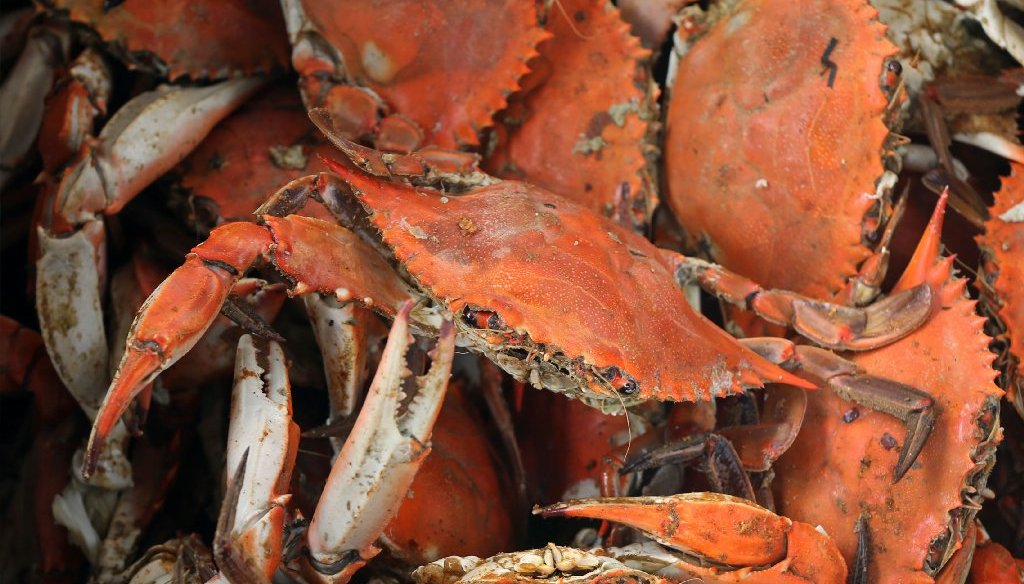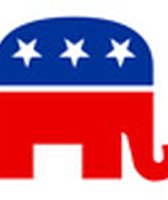Stand up for the facts!
Our only agenda is to publish the truth so you can be an informed participant in democracy.
We need your help.
I would like to contribute

If it's a blue crab, it was probably born in Virginia. (Photo by the Richmond Times-Dispatch)
Terry McAuliffe says all Maryland crabs are born in Virginia
Maryland crabs, Maryland crab cakes, Maryland crab soup...Virginia Gov. Terry McAuliffe says it’s all a sham.
"You know, Maryland talks about its crabs," McAuliffe said with a chuckle during a July 21 radio interview. "If anyone from Maryland is listening, I want to make this perfectly clear: All the crabs are born here in Virginia and they end up, because of the current, being taken (to Maryland). So really, they should be Virginia crabs."
No such thing as a Maryland-born crab? Let’s crack this claim open.
McAuliffe’s office referred us to the website of the Chesapeake Bay Program, an environmental protection partnership between the federal government and five states, including Maryland and Virginia.
We learned that blue crabs mate in the middle of the bay from May to October. This happens when the female molts and the male cradles her, injects sperm, and holds on until she’s developed a new, hardened shell. After their affair, the male takes off looking for new paramours and the female migrates to the saltier waters of the lower Chesapeake Bay.
McAuliffe’s office also sent us a map showing that the areas of high salinity are in Virginia near where the mouth of bay opens into the Atlantic.
All this information seemed to confirm the governor’s statement, but did not specifically state that all bay crabs are born in Virginia. Nor did it answer a more delicate question: Even if the crabs are born in Virginia, could it be argued that the moment of conception for many actually occurred in Maryland?
We turned to Romuald Lipcius, a professor at Virginia Institute of Marine Science. He told us that the females, a half year or so after they’ve mated and settled in the saltiest waters, develop sponges that carry as many 2 million eggs. The eggs, when ejected, pass through a sperm packet left by the male, become fertilized and emerge as larvae.
In other words, the moment of conception and birth -- which Lipcius says are interchangeable terms in crab world -- almost always occur in Virginia. "The bottom line is that the governor is essentially correct," he said.
We sensed some hesitancy.
"In drought, the salinity can get very high in Maryland and it’s possible for females to give birth there," Lipcius explained.
Tom Miller, a professor at the University of Maryland’s Chesapeake Biological lab, said McAuliffe is basically right. "There’s no such thing as a Maryland-born crab in the Chesapeake Bay," he told us. "Blue crabs require salinity of 26 parts per 1,000 to survive. You don’t find that on the Maryland side."
Miller said there are Maryland-born crabs, however. A comparatively small number are born outside the bay, in coastal waters around Ocean City, Md. "But when people think of crabs, they think of the Chesapeake," he added.
Here are a few other facts about crabs:
•After their birth in the lower Chesapeake, the larvae drift into the even saltier Atlantic for a few weeks, then return to the bay and flow with currents to grassy waters. That’s how many end up in Maryland.
•Females mate once in their lives and settle permanently in the salty waters. They still produce eggs, however, and the packet left by males contains enough sperm to fertilize eight sponges of eggs. Think about it: One sexual encounter could lead to 16 million larvae. But few survive into adulthood.
•They taste great with beer.
Our ruling
McAuliffe said, "All (Maryland) crabs are born in Virginia."
He’s right when we’re talking about Chesapeake Bay crabs. There are, however, a small number of crabs that are born outside of the Chesapeake in Maryland coastal waters.
So we rate the governor’s statement Mostly True.
Our Sources
Gov. Terry McAuliffe, "Ask the Governor," WRVA Radio, July 21, 2015.
Email from Angelica Smith, intern for McAuliffe, July 23, 2015.
Chesapeake Bay Program, "Blue crab," accessed July 23, 2015.
Chesapeake Bay Program, "Map: Chesapeake Bay mean surface salinity - Fall (1985-2006)," Feb. 13, 2008.
Interview with Romuald Lipcius, professor at Virginia Institute of Marine Science, July 24, 2015.
Interview with Tom Miller, professor at the University of Maryland’s Chesapeake Biological lab, July 24, 2015.
Interview with Chris Moore, senior scientist with the Chesapeake Bay Foundation, July 24, 2015.
Browse the Truth-O-Meter
More by Warren Fiske
Terry McAuliffe says all Maryland crabs are born in Virginia
Support independent fact-checking.
Become a member!
In a world of wild talk and fake news, help us stand up for the facts.






















































